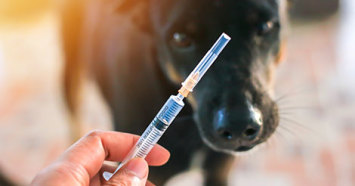
Lyme disease is an infection in dogs caused by the bacteria Borrelia burgdorferi. Humans, and rarely cats, can also become infected. Lyme disease is transmitted by ticks, primarily the deer tick (i.e. Ixodes scapularis, black-legged tick) and the western black-legged tick (i.e. Ixodes pacificus).
Ticks must be attached for at least one to two days to pass the infection to a dog. Symptoms of Lyme disease, which can take two to five months to develop after a tick bite, can include:
Fever
Enlarged lymph nodes
Trouble walking
Swollen joints
While treatment is available, some dogs do not respond to treatment. Many dogs that do improve with treatment will experience symptom relapses.
Types of Lyme Disease Vaccine Available for Dogs
Two types of Lyme disease vaccines (i.e. Borrelia vaccines) are available for dogs:
Adjuvant form
Recombinant form
Both work to prevent transmission of Borrelia bacteria from the tick to the dog during a tick bite. Lyme disease vaccines do not cause Lyme disease, and they do not prevent disease development in dogs already infected.
It is important to know that both types of vaccines are only about 80% effective in preventing Lyme disease. In other words, about 20% of vaccinated dogs can still become infected with Lyme disease. Some scientific studies indicate that Lyme disease vaccines for dogs may only last about six months, although many more studies are needed to determine if this is true.
Does my dog need a Lyme disease vaccine?
Unfortunately, the answer isn’t straight forward. The American College of Veterinary Internal Medicine states that Lyme disease vaccines are not considered part of the core group of vaccines necessary for all dogs. Lyme disease vaccine is primarily recommended for dogs that live or frequently visit areas known for Lyme disease as well as for those living in areas with high potential for tick exposure.
Vaccinating for Lyme disease in sick dogs or those who have urinary protein issues is not recommended. Veterinarians and researchers also debate whether vaccinating a dog that already has Lyme disease is necessary. Some say it will help prevent the dog from becoming infected again, while others worry that the vaccine could cause a serious reaction, making the dog even sicker.
Side Effects of Lyme Disease Vaccine
No major side effects exist with the Lyme disease vaccine in healthy dogs. As with any vaccines, some dogs may have sensitivity after the vaccine, or they can develop some form of a vaccine reaction. Symptoms of a more serious vaccine reaction can include:
Pain &/or swelling at the injection site
Hives or red patches on the stomach
Swelling of the face
Trouble breathing
Dogs who are infected with Lyme disease, even if not showing symptoms, are more prone to develop severe reaction symptoms. This may be due to their immune system’s response to dealing with both the disease and the vaccine simultaneously. If any unusual symptoms are noted after a Lyme disease vaccine, call your veterinarian for advice.
How often is Lyme disease vaccine needed?
Initially, the vaccine is given as a series of two boosters (i.e. two vaccines given two to four weeks apart). Depending on the vaccine’s manufacturer, this series of vaccines can be started around eight to nine weeks of age.
Some veterinarians recommend boostering this series six months later, followed by another booster in six months, then once yearly after that. Other veterinarians recommend vaccinating yearly after the initial two booster series. When and how often to booster will likely be based on the concern for Lyme disease in your area and your pet’s risk for tick bites.
What can I do to prevent Lyme disease in my dog?
Tick control is an essential part of preventing Lyme disease, even in vaccinated pets. Tick prevention for each pet must be considered, such as tick collars, or topical/oral tick products. Consider also treating your yard if a heavy tick infestation is present.